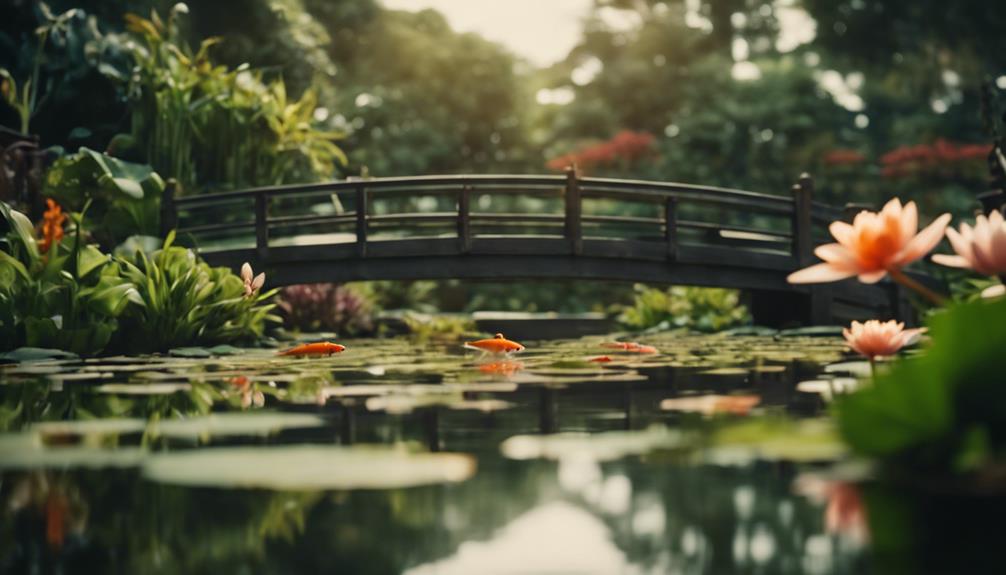You're about to start breeding beautiful koi, and with the right techniques, you'll be well on your way to creating stunning, high-quality fish. First, prepare a dedicated spawning tank with ideal water conditions, filtration, and aeration. Understand the koi mating process, and select breeding stock with desirable characteristics. Create a suitable breeding environment, then carefully manage spawning and egg care. After that, focus on post-spawning care, and learn how to select high-quality koi. By following these essential techniques, you'll overcome common challenges and be on the path to breeding truly magnificent koi – and there's even more to explore in the world of koi breeding.
Table of Contents
Key Takeaways
- Set up a dedicated spawning tank with ideal water conditions, filtration, and aeration to stimulate breeding and ensure healthy development.
- Select high-quality breeding stock with desirable characteristics, such as vibrant colors, well-defined patterns, and sturdy body shapes.
- Monitor and control water temperature, pH, and quality during spawning, and remove parents after spawning to prevent egg consumption.
- Provide gentle aeration, slow water changes, and a nutrient-rich diet to promote healthy growth and development of koi fry.
- Regularly monitor and maintain a clean and healthy environment, including the mud pond, to ensure the health and well-being of koi fish.
Preparing for Koi Breeding
Before you plunge into the world of koi breeding, take a step back and assess your current setup, ensuring you have a solid foundation to support the demands of this intricate process.
You'll need a dedicated spawning tank, specifically designed for koi breeding, to provide the right conditions for your fish to thrive. This tank should be separate from your main pond to prevent the breeding process from disrupting your existing aquatic ecosystem.
When setting up your spawning tank, consider factors like water quality, temperature, and filtration.
You'll want to maintain ideal water conditions, with a pH range of 6.5-8.5 and temperatures between 65-75°F (18-24°C). Adequate filtration is also vital to remove waste and excess nutrients that can harm your fish.
Understanding Koi Mating Process
As you venture into the fascinating world of koi breeding, mastering the intricacies of the koi mating process is vital, which involves a complex series of events that require precise timing and conditions.
During the breeding season, usually in early spring, koi will spawn when the water temperature reaches around 64°F to 75°F (18°C to 24°C). To increase the chances of successful spawning, you'll need to provide the right environment.
This includes installing spawning ropes, which are specialized ropes that provide a surface for the eggs to attach to, and ensuring the pond is free of predators and has adequate water quality.
As the breeding season approaches, you'll notice changes in your koi's behavior, such as increased activity and aggression.
This is normal, as they're preparing for spawning. Once the conditions are right, the male koi will begin to chase the female, and the spawning process will begin.
Monitoring the process closely is imperative, as you'll need to remove the adults from the pond after spawning to prevent them from eating the eggs.
With the right conditions and care, your koi will spawn successfully, and you'll be one step closer to breeding beautiful koi.
Selecting Breeding Stock
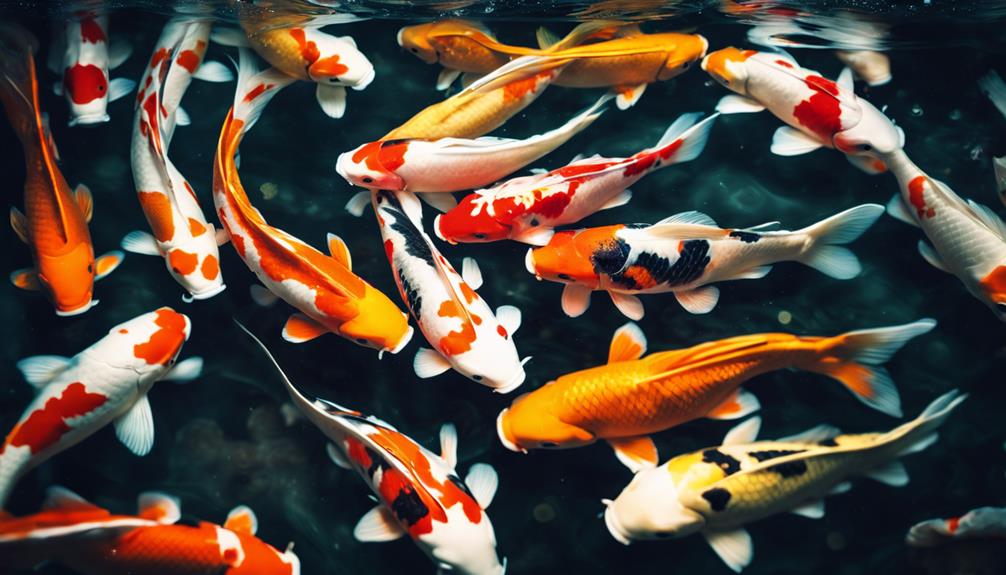
When selecting breeding stock, you'll want to evaluate your koi based on specific characteristics, such as color, pattern, and body shape, to guarantee you're choosing the best parents for your desired offspring.
This is vital in breeding beautiful koi that exhibit the qualities you're looking for.
To start, identify the breed specific varieties you want to work with and separate the males and females accordingly.
A breeding set typically consists of one male and multiple females, as males can fertilize multiple eggs.
Look for koi with vibrant colors, well-defined patterns, and a sturdy body shape.
Avoid selecting koi with deformities or weaknesses, as these can be passed on to their offspring.
You'll also want to ponder the size and age of your koi, as larger, more mature fish tend to produce healthier offspring.
Creating a Breeding Environment
Now that you've selected your breeding stock, it's time to create an environment that will encourage spawning and support the healthy development of your koi.
To create a suitable spawning environment, you'll need shallow water, which can be achieved by using a net or a temporary pool with a depth of 10-12 inches (25-30 cm). This mimics natural spawning conditions and stimulates your koi to spawn.
Make sure the water is immaculately clean and free of parasites, and slightly increase the temperature to stimulate spawning.
Add gentle aeration to provide a good environment for the developing eggs and fry. The water temperature should be between 18-25 degrees Centigrade.
You can use spawning ropes to stimulate the fish to spawn, mimicking natural vegetation. Remove them after the fry have swum up and taken their first gulp of air.
Keep the water fresh with slow water changes to promote healthy development.
Don't feed the fry until they're fully functioning, as they're still developing their mouths and swim bladders.
Spawning and Egg Care
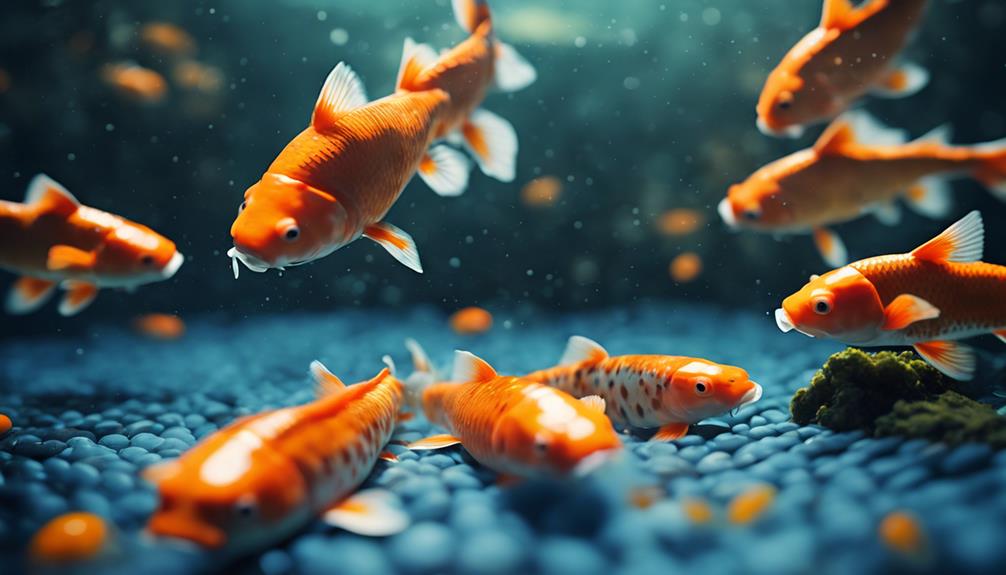
You'll need to carefully manage the spawning process and provide ideal care for the eggs to guarantee a successful hatch and healthy fry development. For successful breeding koi, use a clean spawning pool with fresh water and spawning ropes to create the right environment. Remove the parent koi after spawning to prevent them from eating the eggs. You'll be amazed at how many koi eggs you'll get – a female can produce between 100,000 to 120,000 eggs per kilo of body weight!
| Egg Development Stages | Description |
|---|---|
| Unfertilized Eggs | Whitish, fuzzy, and should be discarded |
| Fertilized Eggs | Begin to hatch 3-6 days later |
| Hatched Eggs | Eggs hatch after 3-5 days, depending on water temperature |
To prevent fungal growth, add malachite green to the water, and perform a water change to remove any stench or cloudiness caused by mating. Monitor the eggs closely, and you'll soon be rewarded with newly hatched koi fry. Remember, the fry don't have mouths yet, so they'll absorb the remains of their egg sac. By following these essential techniques, you'll be well on your way to breeding beautiful koi.
Caring for Young Koi Fry
As you care for your young koi fry, you'll need to keep a close eye on water quality, making sure it's ideal for their growth and development.
You'll also need to monitor the egg hatching process, ensuring that the fry are receiving the necessary nutrients and oxygen.
Monitor Water Quality
To guarantee the ideal development of your young koi fry, it's essential that you regularly test the water for ammonia, nitrite, and nitrate levels, as well as pH and temperature. This confirms a healthy environment for your koi to thrive in.
Some vital steps to maintain prime water quality:
- Perform regular water changes, ideally 10-20% every day, to prevent the buildup of toxins and maintain clean water.
- Verify gentle aeration and circulation of water to prevent stagnation and promote healthy growth of koi fry.
- Keep the water clean and free of debris by using a filtration system and performing regular cleaning of the breeding tank or pond.
- Regularly check for signs of stress or disease in the koi fry, such as labored breathing, lethargy, or unusual behavior, and take prompt action to address any issues.
Egg Hatching Process
By the time koi eggs hatch, typically within 3-5 days after spawning, you're already faced with the vital task of caring for the vulnerable young fry.
Providing a nurturing environment is imperative, as the fry will absorb the remains of their egg sac and begin to swim up to the surface to take their first gulp of air within 3-5 days.
Gentle aeration and slow water changes are vital to support their healthy development, as they're susceptible to disease and parasites during this stage.
As the fry grow, they'll rely on their yolk sac for sustenance for the first few days.
Afterwards, you'll need to provide a clean and nutritious environment to support their growth.
The rate of development varies depending on water temperature, with warmer water promoting faster growth.
Typically, it takes around 7-8 days after spawning for the fry to swim up and take their first gulp of air.
By maintaining ideal water conditions and providing a suitable environment, you'll be well on your way to raising healthy, thriving koi.
Feeding Koi Fry
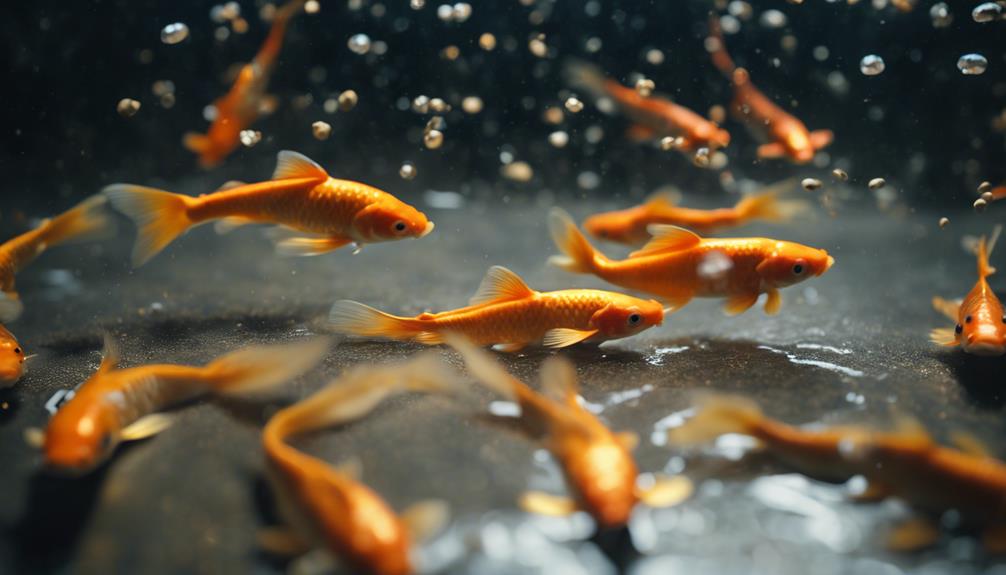
You'll need to feed your koi fry a nutrient-rich diet from the start to guarantee their healthy growth and development. After 3-5 days, they'll develop a mouth and start swimming to the surface to take their first gulp of air. During this formative stage, they use a sticky pad on their heads to stick to surfaces.
Feed your koi fry powdered koi pellets after 10 days, 4 times a day, and increase the food size once they're 1 month old.
Provide live foods like brine shrimp, which can be hatched at home, or use commercial baby koi meal kits.
Offer wholemeal bread, oranges, and whole lettuces as nutritional food options, and feed as much as they can finish in 5 minutes, 4 times a day.
For the first few days, a chicken egg preparation can be used, but don't forget to provide gentle aeration and a steady trickle of fresh, clean water for the fry.
Managing Mud Ponds
Every year, you're tasked with managing your mud pond to create an ideal environment for your Koi to thrive in. This vital step guarantees the health and well-being of your Koi fish, particularly the young fry. A well-managed mud pond allows for the growth of algae and bloom, providing a natural food source for the fry.
| Mud Pond Management | Benefits for Koi |
|---|---|
| Regular draining and drying | Prevents sludge buildup, allows for harvesting |
| Monitoring and maintenance | Provides a safe and healthy environment for fry |
| Harvesting and selection | Allows for selection of high-quality fry, culling of weaker ones |
Selecting High-Quality Koi
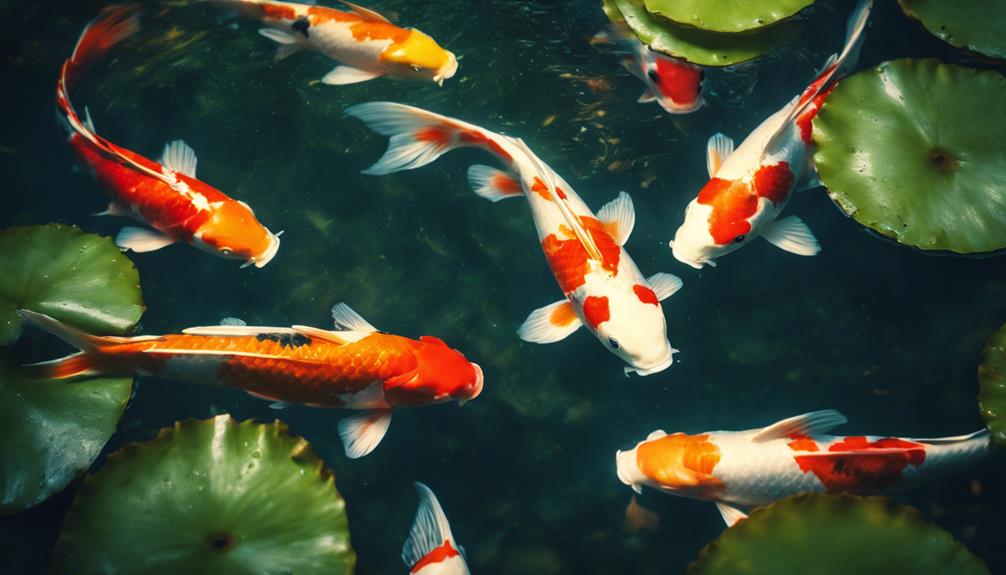
Now that you've created an ideal environment in your mud pond, it's time to focus on selecting high-quality Koi to breed, as the characteristics of your breeding stock will directly impact the quality of your offspring.
When choosing koi, remember that a female koi can produce between 100,000 to 120,000 eggs per kilo of body weight, making selection of high-quality breeding stock vital.
To increase your chances of success, consider the following key factors:
- Choose koi with desirable characteristics, such as healthy scales, fin shape, and color, to produce high-quality offspring.
- Select a larger female koi to reduce the risk of bruising during spawning.
- Consider the various varieties of Koi and their unique characteristics to create a diverse and thriving breeding program.
- Guarantee your breeding set consists of one female and two males, as the presence of multiple males stimulates the female to release more eggs.
Post-Spawning Care
After successfully inducing spawning, your primary focus shifts to providing superior post-spawning care to guarantee the survival and healthy development of the eggs and newly hatched fry.
You'll need to remove the parents from the breeding tank to prevent them from eating the eggs, and give the tank a thorough cleaning and disinfection to prevent fungal growth.
Monitor the eggs closely, and remove any dead or white ones to prevent fungus from spreading to healthy eggs.
Next, provide gentle aeration and slow water changes to promote healthy development of the eggs and newly hatched fry.
Maintain a water temperature between 18-25°C to stimulate healthy growth.
Resist the temptation to feed your newly hatched fry too soon – they need time to fully absorb their yolk sac and start swimming freely, which usually takes around 3-5 days.
Breeding Risks and Challenges
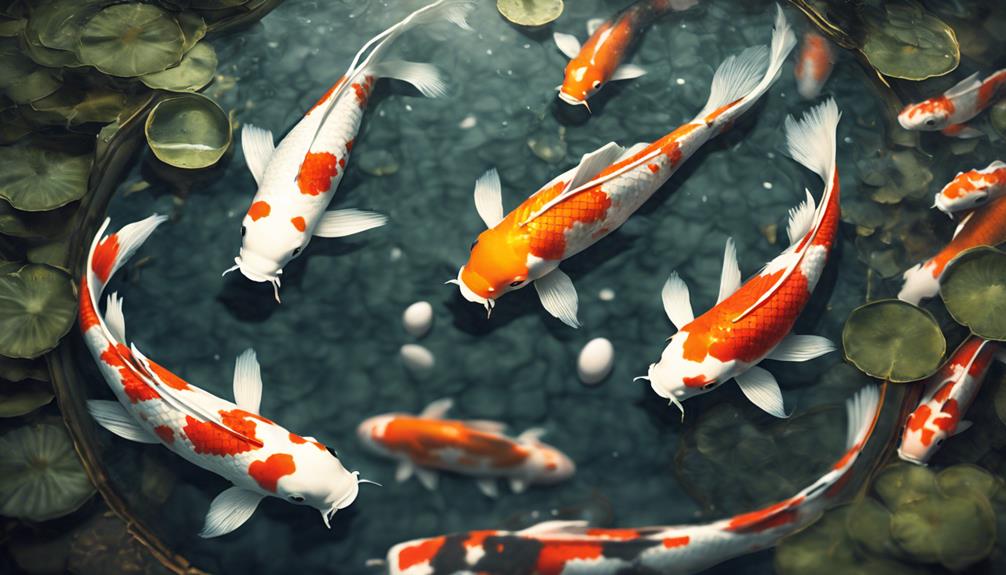
As you venture into breeding koi, you'll quickly realize that it's not all fun and games.
You'll face a financial burden, as the process can be time-consuming and costly, requiring a significant investment of resources.
You'll also have to confront the harsh realities of culling and selection, which can be emotionally challenging, especially for new breeders.
Financial Burden
Breeding koi can quickly become a costly obsession, draining your bank account with expenses that add up faster than you can say 'koi paradise'.
As a beginner, understanding the financial burden that comes with breeding koi is crucial. You'll need to invest in top-quality breeding stock, which can be expensive, especially if you're looking for specific traits or characteristics.
Additionally, you'll need to set up and maintain a breeding environment, which includes purchasing equipment like filtration systems, pumps, and heating systems. These costs can be prohibitively expensive, especially for small-scale breeders.
Some key expenses to weigh:
- High-quality breeding stock
- Equipment like filtration systems, pumps, and heating systems
- Food and care for tens of thousands of offspring
- Marketing and selling expenses to turn a profit
Time-Consuming Process
You'll soon discover that breeding koi is a time-consuming process that demands an enormous amount of space, money, and effort, going beyond the initial financial burden. It's not just a matter of throwing some koi together and waiting for the magic to happen. Breeding koi requires a significant investment of time, resources, and patience.
| Challenge | Description |
|---|---|
| Space | A single pregnancy can result in tens of thousands of fry, requiring a massive space to accommodate them. |
| Risk | Females often sustain injuries during spawning, and parents may eat their own eggs. |
| Time | It can take several years for koi to reach maturity, and breeding for specific colors and patterns can be extremely challenging. |
| Population Management | Culling is necessary to manage the population, as a single pregnancy can produce enough offspring to fill an Olympic-sized stadium. |
| Unpredictability | Breeding koi is not a lucrative business, and it requires a significant investment of time, money, and resources with no guarantee of success. |
As you set out on this journey, remember that breeding koi is a long-term commitment that demands your attention, care, and dedication. Be prepared to face challenges and setbacks, and don't be discouraged by the time-consuming process. With persistence and patience, you can overcome these obstacles and breed beautiful koi that will thrive and bring joy to your life.
Culling and Selection
When it comes to breeding koi, culling and selection are critical steps that require your intense scrutiny, as the fate of your entire operation hinges on making the right decisions about which fish to keep and which to discard.
You'll need to cull your koi at multiple stages, including shortly after hatching, at several weeks old, and again at several months old. This process is vital to eliminate genetic defects or weaknesses and select for desirable traits.
Look for vibrant, even colors and well-defined patterns in terms of color and pattern.
Opt for koi with well-proportioned fins and a sturdy, symmetrical body in terms of finnage and body shape.
Verify your koi are active, energetic, and free from signs of illness or injury in terms of overall health.
Ponder traits that align with your breeding goals, such as unique markings or exceptional growth rates in terms of desirable traits.
Maintaining a Healthy Pond
To keep your koi thriving, it's crucial to create a well-balanced ecosystem in your pond, and that starts with regular water quality checks. You'll want to test the water regularly to guarantee it's safe for your koi, and make adjustments as necessary to maintain a healthy environment.
| Task | Frequency | Why |
|---|---|---|
| Water Quality Checks | Weekly | Guarantee water is safe for koi |
| Water Changes | 10-20% every week | Remove waste products and prevent toxins |
| Monitor Water Temperature | Daily | Stimulate spawning and promote healthy development |
| Add Plants or Decorations | Monthly | Provide hiding places and maintain ecosystem balance
Frequently Asked Questions
How to Get Koi to Breed for Beginners?
To get koi to breed, you'll need to create the right environment by manipulating breeding triggers like water temperature, spawn timing, and water chemistry, making it conducive for your koi to spawn successfully.
What Should You Do Firstly Before Attempting to Breed Koi?
Before attempting to breed koi, you'll want to focus on genetic selection, ensuring you have high-quality parent fish. Next, prioritize water quality, maintaining a pristine environment. Finally, thoroughly prepare your tank to create an ideal breeding space.
What Is the Prettiest Type of Koi?
You're about to discover the most breathtaking Koi type that'll leave you mesmerized! With Japan's rich heritage, the Kohaku stands out with its radiant red and white color patterns, boasting an unparalleled fish scale shine that'll leave you spellbound.
What Is the Best Koi Fish for Beginners?
When choosing a koi for your first time, you'll want to weigh koi coloration, fish size, and pond compatibility. Look for breeds like Bekko or Ogon, which come in various colors, are relatively small, and thrive in smaller ponds or tanks.
Conclusion
As you set out on this koi breeding journey, remember that 'practice makes perfect.'
With these essential techniques, you're well on your way to raising stunning koi.
From preparing for breeding to post-spawning care, each step is vital.
Stay vigilant, and don't be discouraged by setbacks – they're an opportunity to learn and grow.
By following these guidelines, you'll be swimming in a sea of vibrant, healthy koi in no time.

